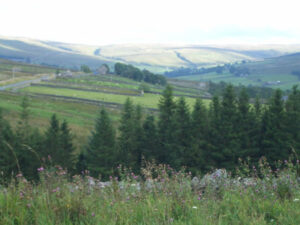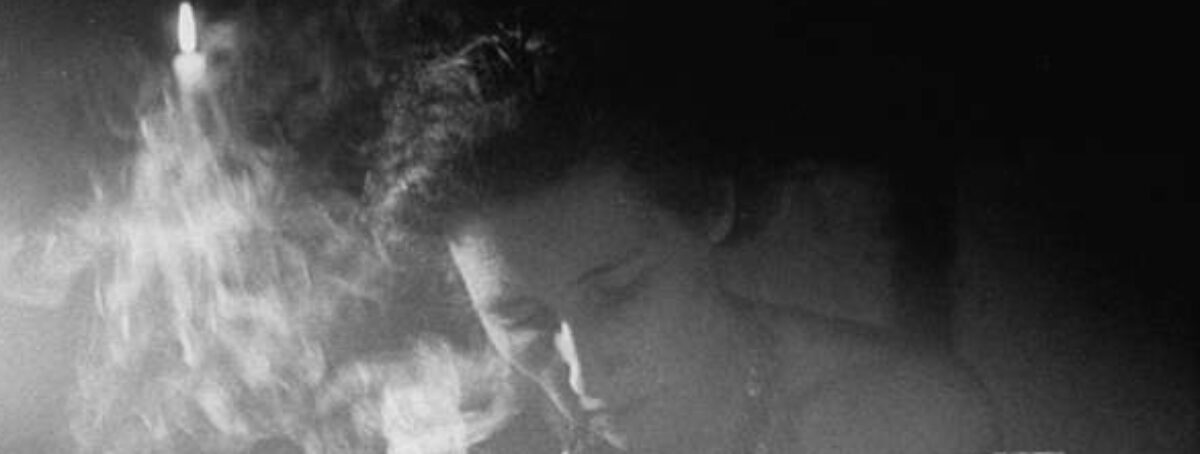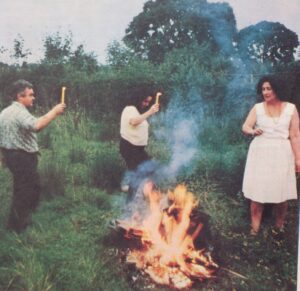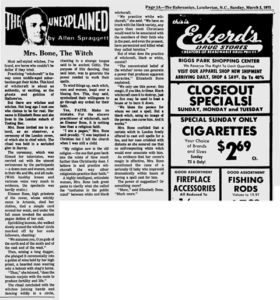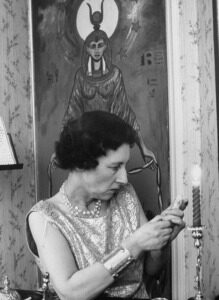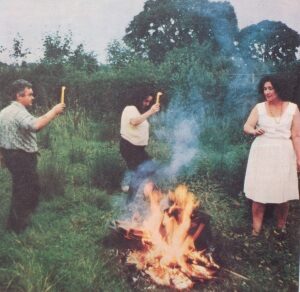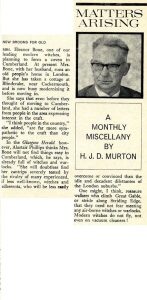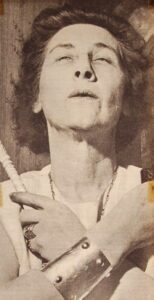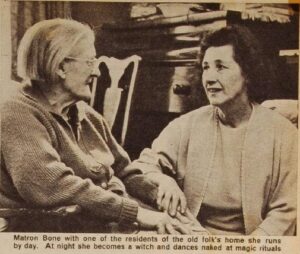Note: This article was published in the Saint Magazine of May 1967. It is quite significant in that it was written by Eleanor Bone herself, and not by a journalist. The magazine was edited by author Leslie Charteris and was a spin-off from the Saint book and television series.
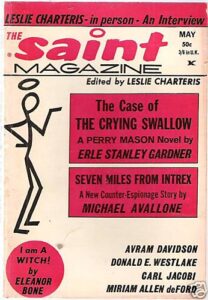
I am a Witch !
by
Eleanor Bone
Last month, I was telling how I had long been intrigued by the discovery that Witchcraft is by no means dead in Europe even today, and indeed seems to be enjoying quite a revival, and how as a preliminary to pursuing this subject I commissioned our favorite researcher W O G Lofts, to do us a background article, which I hope none of you missed.
In the beginning, I planned to write the follow-up article myself, which would deal with the facts of present-day Witchcraft, as best I could discover them without reference to lurid and sensationalized newspaper stories but by finding myself a real live practising Witch and learning all I could as nearly as possible at first hand.
But, as I said last month, when I did make contact with an avowed authentic Witch, my neat professional plan went (as they would say in the Craft) all widdershins.
Her name is Eleanor Bone.
She does not claim, as some publicity-seekers of her sorority have done from time to time, to be “Queen of the Witches” or “High Priestess of the Witches of England” – as she will shortly explain, such titles are strictly exaggerated, since all Covens are completely autonomous, and while members of one may visit with members of another, there is no central parliament or monolithic Authority.
But in the first hour of our first meeting, she talked with such easy confidence and astounding erudition that I very quickly realized that anything I tried to put together from the notes I had frantically started making would be only a hollow travesty of what she had to say. In answer to any question, facts poured out of her as if from an inexhaustible fount of knowledge, yet with the unaffected and unassuming ease of an off-duty doctor discoursing on the fundamentals of his specialty with someone assumed to be his intellectual equal though, in a different field. For me to have tried to write my second-hand version would have been as presumptuous (and superfluous) as if I had interviewed a highly articulate Einstein on the subject of Relativity, and insisted on writing my own article, with all its potential errors, long after I had discovered that his own conversation was much clearer and more informative than any essay I could have based on it.
I therefore ended eventually by asking Mrs. Bone how she would like to write her own article. And this – shorn only of her modest apologies for any lack of professionalism in the writing – is the result.
You may be interested to know what a real witch is like to meet. This one is of entirely average and inconspicuous female stature, at a guess between 35 and 40. The only things about her which you might notice as being in the traditional witch pattern are her rather wild black hair and very piercing eyes: but I think you would only notice them after you had been told she was a witch and had started to search for outward symptoms, and could not honestly say that you would have found them at all remarkable if you had just happened to sit next to her on a bus. In mundane fact she owns and manages a rest home for old people, whom she affectionately calls her “babies”, officially registered with the local Council, which is not reputed to grant such licenses to operators suspected of being deficient in their marbles; she has a pleasantly conventional husband who takes no part in Witchcraft himself but is amiably tolerant of her activities.
She takes her religion (as you will find she thinks of it) seriously enough to have named her private home in the north of England Witchwood. And yet she is so far from being a crank that she has the sense of humor to send her personal letters in envelopes imprinted with the symbol we reproduce here, which is almost a facsimile of the old legendary Witch-image which in her earnest role she disclaims.
To some, this must be an incomprehensible paradox. To me, it is one of her strongest claims to respectful audience. For only very sane people can share a joke about themselves.
J.C.
I am a witch!
This does not mean that I wear a pointed hat and fly around on a broomstick with a black cat on the pillion, nor do I perform miracles with a wave of my hand or a twitch of my nose, like the characters in one television show.
I know that this is the popular image of witches and that they are associated with evil in the minds of many people.
This was the picture created for us as children, when we listened to bed-time stories, most of which revolved around the theme of the good fairy who always succeeded in getting the better of the wicked witch. We read about the three Weird Sisters in ‘Macbeth’ with their portent of evil, ugly old harridans chanting weird incantations as they stirred the noxious brew in their cauldrons. Later we were taught about about the witches of the Middle Ages who were burned at the stake for their wickedness and heresy.
Only a few years ago the majority of people did not believe that witches still existed in the twentieth century. Indeed, many people did not credit that they ever had existed outside of storybooks.
When the last Witchcraft Act was repealed in Britain in 1951, the absolute secrecy which up to then had been essential became of less importance, and it was not long before the general public became aware of covens of witches in their midst. At first people were horrified. Just as in the old days Christians were thrown to the lions, so, in this modern day and age, a more subtle form of persecution was throwing witches to the Press. And what lurid pictures were conjured up! Witchcraft was mixed up with Black Magic, with a suggestion of Black Masses and ‘bloody sacrifices’ thrown in for good measure – to say nothing of sex orgies – a really good entertainment to brighten up a dull Sunday afternoon.
I shall always remember one very charming young woman in her early twenties who came to see me. She told me she was very interested in Witchcraft and desirous of joining a Coven – BUT – she just couldn’t cut an animal’s throat! She really believed that this was part of the ritual and, unfortunately, many other people believe likewise.
From time to time over the last few years, accounts have appeared in the National Press of the desecration of Churches, the disturbance of graves, inverted crosses and other things of a similar nature. Each time this sort of thing crops up there is a suggestion of Witchcraft. It is so easy to blame the witches. My own opinion is that many of these happenings are perpetrated by bright young things who are a little bored with life and who have been reading too much Dennis Wheatley.
Of late, much has been written and said about witches and witchcraft. Writers, sceptics, modern ‘witchfinders’ – even the witches themselves have said their say. One gentleman made witchcraft sound like an American protection racket, whilst another suggested that it had been “garnered from dustbins of the world religions”. We have been painted very, very black and it has been suggested that we are all ‘insecure, frightened, unsuccessful, perverted people’. On the other hand we have been made to appear so ultra-white that we sound like an advertisement for the latest detergent.
Thus I read the article by W.G. Lofts with interest, hoping to find a new slant on an old subject.
However, he appears to have based his article on the suppositions of writers of the Middle Ages whose writings merely reflected the propaganda put about by the Church and State in their fanatical attempt to crush the Old Religion. If one delves into such works as ‘Calendar of State Papers Domestic’ 1584; ‘Compleat History of Magick, Sorcery and Witchcraft’ 2 vols. London 1725; ‘Collections of rare and curious tracts relating to Witchcraft’ London. 1838; Confessions of Witches under Torture’ E. Goldsmid, Edinburgh 1886, and many more I could quote, the, of course, one expects to find this fanaticism. In any case of propaganda one cannot accept accusations at their face value. Incidents become exaggerated into events, knaves become heroes, and vice versa.
Inquisitors caused Joan of Arc to be burned as a witch. She may well have been one – in fact her nickname ‘La Poucelle’ – ‘The Maiden’, – makes this a strong possibility – but this was merely an excuse for her execution, the reason was purely political.
Mr. Lofts tells us a good deal about the persecution of witches in the Middle Ages but he does not give a really satisfactory explanation as to why and when this persecution really began. He tends to pooh-pooh the idea that witchcraft had its origin in the Old Religion.
He also tends to confuse witchcraft with ritual magic – a quite common mistake many lay people tend to make. For example, when he mentions Dr. John Lamb.
Now Dr. Lamb was the personal physician to the Duke of Buckingham. He experimented in ritual magic and alchemy (as did Dr. John Dee in the 16th century, who was imprisoned by Queen Mary and later befriended by Queen Elizabeth I.) He was a magician, not a witch. He was stoned to death by a mob in 1640. King Charles I rode out personally to stop the riot. However, he arrived too late. He fined the City of London £600 for failing to punish the ringleaders. Surely a man on whose behalf the King himself intervened must have been held in esteem by the royal circle, and witches certainly did not rate highly enough for such attention.
As Mr. Lofts points out, witch trials did indeed follow a pattern. They appear to have consisted of a number of leading questions which in the Courts today would never be allowed. After the accused people had been subjected to callous treatment and a good deal of brain-washing, it is not surprising that they should agree to anything suggested.
I think it is quite untrue to say that there are no records of big English Witch Trials to compare with the Salem Trials. The mass trial of twenty witches in 1612 was described in a chapbook entitled The Wonderful Discoverie of Witches in the County of Lancester by Thomas Potts (London 1618), and the same Pendle Witches were immortalised by Harrison Ainsworth in his book The Lancashire Witches. They even inspired a first novel in 1951, Mist over Pendle, with which the author, Robert Neill, established his reputation.
The first really notable trial was that of the Chelmsford Witches in 1566. Then there were the trials of the St. Osyth Witches 1582 and the Warboy Witches in 1589. The trial of the Bury St. Edmunds Witches in 1662 was much documented and publicized and, in fact, it was this trial that influenced very strongly the conduct of the Salem trials.
I am quite sure it was never alleged that physical deformities were the characteristics of every witch. Many attractive women of all ages were tried. For example, Lady Alice Kyteler, the first Irish witch to be tried.
This trial was instigated by Bishop Ledrede of Ossory, a Franciscan trained in France. He undoubtedly learned of witch trials there and tried to introduce them to Ireland. Since Lady Kyteler was the wealthiest woman in Kilkenny, her wealth was probably the attraction, because conviction for heresy meant confiscation of estates. She defied the Bishop, who ex-communicated her. However, Lady Kyteler imprisoned the Bishop, and eventually the whole affair was settled with Lady Kyteler triumphant.
On present-day witchcraft Mr Lofts seems somewhat uncertain of himself, his information appears to have been gleaned from newspaper articles and then not always correctly.
For one thing the late Gerald Gardner did not state there ‘were enough witches to bring about world peace’. The exact words, used by a young British High Priestess in 1958 were these: – ‘WERE there enough white witches around, they could bring about world peace’.
Again, the Witches Mill at Castletown, Isle of Man, is not the only Museum of Magic and Witchcraft in the world. Until a few weeks ago there was one at Bourton on the Water, Gloucestershire and there is another at Boscastle, near Tintagel.
I must say that a quotation of Edgar Allan Poe would not have been my way to close any article if I wished to convince people. Most people know very little of his serious works – I think he is far better known for his macabre writings which appear to have been inspired by a weird and morbid, though fascinating, imagination. Whilst his character was not as black as his first biographer, Rufus Griswold, pictured it, at the same time it was not very good. He died in an institution as the result of a drunken bout. I have always felt that he might well have been a schizophrenic and I think The Raven indicates this split personality, perhaps more than any other work. This particular quotation was taken from The Raven. In any case, quotations taken out of context prove nothing, even though a dramatic note is achieved.
What, then, is the truth about us living witches?
To find the origin of Witchcraft we must go back to pre-Christian times. The word witch is derived from an Anglo-Saxon word wicca meaning ‘wise one’. The witches were the priesthood of the Old Religion, which was a combination of the worship of the Sun and Moon, indeed, it embraced all facets of nature. In many old cults it was customary for the rites of the priesthood to be kept secret and this is one of the reasons for the secrecy which surrounds the rites of the witches even to this day.
It was to the witches that the ordinary people went when they needed advice. They were skilled in the art of ‘wort-cunning’ – this was the old name for herbal cures – and so they healed sick people and sick animals, and helped and advised in many ways. I always think they must have been very good psychologists, too.
In a pastoral community, the fertility of men, animals and crops, was of primary importance. The rites performed by the witches were to achieve these ends. They believed that if they wanted the Gods to help them, they must help the Gods. A very sound idea when you think about it; after all, we cannot expect to get anything out of life unless we put something into it. We must remember that these rites and sacrifices were not part of the philosophy – they were a form of sympathetic magic. As the priesthood grew stronger, so the number of rites increased. Is this not typical of priesthoods everywhere? So often the dogma, which is quite often absurd, becomes so important that the original teaching is almost hidden from view. This seems to happen in every religion, it adds to the importance of the priesthood and makes it indispensable.
It is in these rites that we find the origin of the broomstick story. The witches used to dance around the fields astride their broomsticks. They believed that the higher they could leap, the higher the crops would grow. As time went by, the story became exaggerated so that they were reputed to have flown through the air! In the same way, when they desired the fertility of animals they would dress themselves in skins and animal masks, and mimic the actions of the animal for whom they desired fertility – a form of sympathetic magic. This may well have been the origin of the superstition that witches could change themselves into animals at will.
The Old Religion was a simple one – simple beliefs for simple people. They observed a God and a Goddess, the God equated the Sun, the Goddess to the Moon or Earth Mother. These deities were known by many names in different parts of the world throughout the ages.
It is not until the Middle Ages that we begin to hear of the Coven consisting of twelve persons and a leader. This does not necessarily mean that they were non-existent, only that there is no record of them.
Idries Shah Sayed in his book The Sufi puts forward a theory that this was due to Saracenic influence. Whether we are in agreement with him or not I feel that this theory must be examined.
In the 9th century the Aniza shool of mystics was founded by Abyu el Atcahia. After his death a group of this school migrated to Spain, which had been under Arab rule for over a century at that time. This Berber off-shoot was known as ‘the Two Horned’. They adopted as a symbol the Goat, cognate with the tribal name Anz, Aniza. A torch set between the horns symbolised the illumination from the intellect of the Aniza teacher.
Let us look at some of the similarities between these people and the witches.
Both use the term ‘ Old Religion’ and ‘Ancient Tradition’.
The witches refer to their deities as ‘the Old Ones’ – the deity of the Sufi is ‘the Ancient One’. The black-handled knife of the witches is the athame – the ritual knife of the Sufi is the adh-hame. The word Sabbat could have been derived from the az-zabat – the ‘forceful occasion’. The patron saint of the Sufi is khidr – the Green One, whilst the Green Man has always been associated with the witches.Whilst these similarities do not constitute proof, at the same time they lend strength to the hypothesis. We know that the Goat became identified as the Devil in Spain, and at about that time the Devil in this country suddenly developed two horns and a tail.
The survival of the old pre-Christian religion could have been greatly strengthened by the importation of the Saracenic cult and therefore have caused fear and misgiving to the Church of the middle ages. The New Religion was still not old enough nor stabilised enough to feel completely secure.
As in days gone by one cult absorbed many of the beliefs and rituals of other cults, so had the Church absorbed many of the solar and lunar theogonies of the Old Religion. In the same way the old pagan Mother Goddess Bride was, for proselytising purposes, canonised as a Christian saint.
It must be remembered that in the early days Christianity was brought to England by foreigners. Augustine was an Italian and in the 7th century the Church here was organised by Theodore of Tarsus aided by Hadrian the Negro. For several hundred years the influx of pagans greatly outweighed the small number of immigrant Christians. When William the Conqueror defeated Harold, whilst he himself was a professing Christian, most of the population were pagan. Even the Priests often served both the Old Gods and the Christian God. In 1282 it is recorded that the Priest of Inverkeithing led the fertility dance round the churchyard, for which he was severely reprimanded by his Bishop.
In the 13th century Witchcraft was declared to be a sect and heretical, but it was not until the 14th century that the two religions really came to grips. The battle raged through the 16th and 17th centuries, the pagans fighting the gallant but losing fight. In this country the treatment meted out was considered to be more lenient than in some European countries, where thousands were consigned to the flames. Still they clung to their faith and suffered and died in agony rather than renounce their old Gods. If they were burnt, they believed they would become sacrificial victims, and in this way serve their gods in the struggle against evil, and also ensure fertility to the community. I think they can well command respect for their integrity of purpose.
Now, however hard a large majority of people try to stamp out something of which they do not approve, and especially something which they fear, there will always be a small group of faithful adherents who will cling firmly to their beliefs and instil them into others who wish to hear. So it has been with the Old Religion. Throughout the years the beliefs have been passed down, and many of the rituals too, so that today we can still hold our meetings and practise our rites as did our forefathers.
Religion is surely man-made, tailored to suit the particular environment at a particular time. Although as a child I was baptised into the Church and attended Church and Sunday school regularly, yet at an early age I realised that this religion was not for me. Being an only child I spent a great deal of my time reading. I enjoyed reading books about the Old Gods and Goddesses; the religion of the Ancient Egyptians and Greeks; the Celts and the Norsemen and the Phoenicians. In all these religions I found the same pattern – the worship of a great Life Force. This appealed to me. Here, I felt, was something I understood, something in which I really could believe, it seemed almost familiar – maybe the echo of something I had known long ago. I felt nearer to the heart of everything out in the open spaces, in woodlands, on hilltops, by running water, than I had ever felt within the four walls of any church. As I grew older this feeling increased – unconsciously I was seeking people who felt as I did.
In the early years of the war I was living and working in Cumberland. I became friendly with a colleague of mine. She was a sympathetic and understanding person, and often at weekends we would go for long walks in the country. One afternoon we were sitting beside the river and I found myself telling her my thoughts and my beliefs. She was extremely interested and suggested that I meet some friends of hers whom she knew would be sympathetic to my ideas.
In due course I did meet them and became a regular visitor to their home. We did indeed have many things in common and it was not long before I realised that at last I had met people who shared my beliefs. I must explain that up to this time I would never have placed the tag of ‘witch’ upon myself. I merely looked upon myself as a pagan, a nature worshipper – I could never believe Great Pan was dead…
Then, one night Mary talked to me and said that she and her husband were now quite certain that I was ‘one of them’. She went to explain that they were members of a Coven of witches.. Witches! For a moment time seemed to stand still… and then – I knew that this was indeed the answer. The last elusive piece of the jigsaw puzzle had been fitted into its place and the picture was complete. I saw quite clearly in that moment that it was not the Devil whom the witches in the Middle Ages had worshipped, it was the old Horned God. Great Pan was not dead and never would be…
At their next Coven meeting I was initiated and taken into the Circle. I am bound by an oath of secrecy not to reveal the secrets of the Craft so I cannot tell you very much about the initiation. It is as vivid in my mind now as it was twenty-five years ago.
It was a clear moonlit night. A necklace was placed around my neck, I was bound with cords and blindfolded, then wrapped around in a coarse, woollen cloak and led through the garden to the woodland where they held their meetings on fine nights. I could feel the dew on my bare feet – I could smell the grass and the leaves and the flowers – all my senses seemed quickened. Suddenly we stopped, and the friendly hands that had been guiding me were no longer there. I was standing blindfolded, bound, helpless and alone – oh, so alone… It was an eerie sensation. I felt completely disorientated, almost panic-stricken. Where were the others? A twig crackled – only some small animal moving in the undergrowth, but quite startling to me. Somewhere a dog barked. The waiting time could only have been a few minutes but it seemed an age. Then, suddenly, the cloak was stripped from me and I shivered as I felt the cool night air on my body.
“Oh thou who standest on the threshold, between the pleasant world of men and the dread domains of the Lords of the Outer Spaces, hast thou the courage to make the assay? For I say unto thee verily, it were better to rush upon my blade and perish than mate the attempt with fear in thy heart.”
I felt the pressure of cold steel against my breast, my heart beat madly – I felt almost suffocated – and then – strong arms swept me into the Circle – and the initiation went on.
After I took my oath the blindfold was removed also the cords and I was welcomed by my fellow witches. Then I joined in the Meeting Dance, starting slowly and then working up to greater and still greater speed until my feet seemed scarcely to touch the ground, and the feeling of exhilaration was indescribable.
After it was all over I felt a great peace and I knew that I had come home at last.
I know that the fact that we do not wear clothes at our meetings has become quite a moral issue with our detractors. I would like to point out that nudity has nothing whatever to do with the morality or immorality of an individual. They can achieve immorality without removing one garment.
People sometimes ask me if I felt at all embarrassed by my first ritual nudity. I know that it is sometimes a little difficult when looking back over a number of years, to be completely clear about one’s reactions in certain situations, but I think I can quite honestly answer ‘NO’. In the Circle bodies seem to be of only secondary importance – the atmosphere is more of a spiritual one. This is not only my personal experience: I have heard other people proffer the same opinion, some of whom had felt beforehand that nudity would be an ordeal in itself.
Of recent years I have belonged to the Naturist movement as have some of my witch friends. However, not all witches find it attractive. I find it most relaxing – it is as if with the putting away of clothes, one also puts away the everyday worries and problems. This is purely psychological and possibly the same effect is not felt by everybody.
I receive many letters and meet many people who have an urge to become witches. Some of them are merely curious, others would obviously like to come in for ‘kicks’ – the latter, I feel sure, would be very disappointed if they did get in.
Some people we know instinctively are ‘right’ for us; even so, we do not bring them into the Circle immediately. We do not seek converts – people who really belong will find their way to us, just as I found my way.
Are people born witches? I find that requires a great deal of thought. I suppose they are. This does not necessarily mean that either their parents or their grandparents were witches; but in all probability, if they could go back far enough, they would find witch blood in their family. I think they are certainly born with a feeling about it all which develops strongly if it is given a chance. I must admit that I get highly suspicious when I receive letters which state: – “I am a witch, my grandmother was a witch, she initiated me when I was seven years of age.” If she did, then she wasn’t the ‘wise woman’ she should have been. Quite often, I’m afraid, such letters are written by either cranks or poseurs.
Unfortunately there are far too many of this sort, and I think perhaps it is this type to whom Mr. Lofts refers when he mentions ‘publicity seekers’. Real witches do not seek publicity – they are sought.
During the last few years a new phrase has cropped up – ‘Queen of the Witches’ – ‘King of the Witches’. This tends to be very misleading as one claimant after another pops up making such sweeping statements. People wonder what is going on in the world of the witches. Well, I would like to make one thing quite clear – these people are only self-styled: there never has been and never will be a King or Queen of the Witches. I think these people may have read a book by the late Dr. Margaret Murray where she refers to the ‘Reine du Sabbat’ – ‘Queen of the Sabbat’ – which of course refers to the Maiden or High Priestess of the Coven who presides at the Sabbat.
Why do they do it? If it is to create an impression it usually defeats its object, as so often the impression created is not a good one and tends to present such an odd image of witchcraft to the public.
The reason that a woman leads a coven is, of course, quite obvious. It is because it was originally a Matriarchal cult, and at that time (the late Stone Age – before the institution of fatherhood and marriage) woman was not considered to be inferior to man.
Whilst I am exploding modern myths about witchcraft, I cannot pass over the ‘witch wedding’ story. Not very long ago I was a picture in a newspaper and read a description of a so-called ‘witch wedding’. Well, it was merely a version of the old Scottish and Romany ‘hand fasting’ with a little bit of extra mumbo-jumbo thrown in. The participants were reported to have declared that having gone through this ceremony they had no need of a civil wedding. As the female was under twenty-one and the man over twice her age there was a good deal of criticism.
Now as there is no such ceremony in witch rituals and it all sounded rather silly and nasty, I drove 175 miles for the purpose of tackling the alleged ‘witch’ responsible. Having run him to earth at last and made it quite clear what I though about him, he decided that he couldn’t fool me. He admitted that he had just staged it to show ‘what a witch wedding would be like if if there had been such a thing.’ At the same time I found out that whatever he was practising, it certainly was not genuine witchcraft. It was some weird mixture of cabalistic and Egyptian magic gleaned from books with a few inventions of his own. He showed me something he called a ‘witch ring’ (The number of witch rings I have been shown in my time! Most of them oddities either picked up for a few shillings in the Portobello Road or somewhere of that kind, or else made by somebody who is prepared to supply ‘ritual items’ at fantastic prices; a few have been quite valuable and attractive but possessing no occult properties whatsoever).
More recently still a young man who felt that he had been ‘let down’ by the Christian faith gave an interview to a journalist. He had prayed for his Mother to live and when she died he decided that God was no good and so he would become a Devil worshipper. Well, if it makes him any happier, that is up to him; but he didn’t leave it at that. He proceeded to state “In Witchcraft it is paying humble homage to Satan”. He also announced his plans to start a witch coven. Obviously he was a very mixed up young man, and personally I feel he is to be pitied, but it is people of this sort who bring the Craft into disrepute.
Another report in a paper was headed in large block capitals: WITCHCRAFT – COURT STORY OF COLOURED GIRL’S MAGIC SPELLS. It was an account of a murder case and mention was made of a person being put into a nut which was invisible and flew over rivers. Having forced myself to wade through this odd report I came to the conclusion that ‘NUTS‘ was the operative word!
I do believe that many people are pagans without actually being witches, just as many people are Christians without being priests, and these people can be of great value to the Craft. Not very long ago I was given a ceremony which appeared to have probably originated in the Middle Ages, for the purpose of bringing people into the Craft without actually bringing them into the Circle, so that they could attend a Meeting, witness it, and join in the feasting and Meeting Dance at the end. Whilst I have not yet used it, I am hoping that at some future date we shall be able to incorporate it in our rites.
Perhaps one of the attractions that the Craft holds for many people is that whilst it is a religion it is not hidebound and cluttered with dogma. Today our beliefs have taken a rather different complexion. Whilst we still observe the traditional God and Goddess in our rites, we do not look upon them as personalities. We believe them to be personifications of the masculine and feminine aspects of the great Life Source – positive and negative, if you will. We have no printed text-books telling us what we may do and what we may not do. Every Coven is autonomous, and whilst the fundamental principles are the same, rites can be very in different covens just as they did in days gone by.
In the Middle Ages, witches were instructed to keep a book in his or her ‘own hand of write’.In times of danger it was destroyed. This tradition is carried out to this day. This book is known as “The Book of Shadows”. In it we write the rituals we use on various occasions, chants, initiation rites, old herbal recipes, and the like; sometimes when we are engaged in research we come across fragments which we add to it.
At the time of the persecution the witches tended to dispense with their books and pass things on by word of mouth instead, as a safety measure. Unfortunately this meant that over a few hundred years certain things became altered, other things were lost, so that we are continually seeking for bits and pieces to add to our knowledge.
We hold thirteen meetings a year, once every lunar month, as near to the full moon as possible. We observe the four Great Sabbats – Beltane (May eve), Lammas (August Eve), Hallowe’en (November Eve), and Candlemas (February Eve), which have been celebrated since very early days. In those early days Hallowe’en was called Samhuin, which means ‘Summer End’ (in those days there were only two seasons – Winter and Summer). Candlemas was known as the feast of Feil-Bride in honour of the Goddess Brigid. She was the Goddess worshipped by the great tribe of the Brigante who occupied most of Northern England at that time.
We prefer to hold our Meetings in the open whenever possible – not always easy in this unreliable climate, I’m afraid. Our Midsummer Eve Meeting always takes place in the open. This is one of the Meetings at which we allow sympathisers to be present.
First of all the High Priestess forms the Circle with the athame – the black handled knife – then she invokes the Four Quarters to guard the Circle. A fire is lit in the centre of the Circle,a nd the Cauldron, filled with water and decorated with summer flowers, stands in the East. The witches stand around the circle whilst the High Priestess invokes the Sun. She then bids the witches: “Dance ye about the Cauldron of Cerridwen” (Cerridwen was an old Welsh name for the Earth Mother, and her Cauldron is taken to represent the Holy Grail of Immortality.) They dance around chanting, gradually gaining speed. Then, led by the High Priestess and the High Priest, they leap over the fire in couples. This is to stimulate the life giving forces of the Sun at the beginning of its downward course.
Every Meeting ends with a Cakes and Wine ceremony. Some people have suggested that this was a travesty of the Sacrament, but of course, this is quite incorrect. It is purely a rite of thanksgiving for the corn and the grapes that have ripened to give food and drink.
At every Meeting we do work for people. Sometimes healing, sometimes helping to sort out their domestic problems – people come to ask our help for all sorts of reasons. We do our best to help them. Of course, there are exceptions when we don’t, such as the lady who felt it would be nice and handy if we could dispose of her unwanted husband. I will say we have more successes than failures. If you are a skeptic you can call it ‘coincidence’; nevertheless, it happens, as many people can testify.
Again, different covens have different ways of working. We always found dancing and chanting very satisfactory. Occasionally we use wax images. Many people only think of wax images as something to stick pins in, to cause illness or death (It’s those ‘Old Black Magic’ books again!) so it will no doubt come as a surprise to know that a wax image can also be used for healing purposes. We make the image of pure beeswax, and then one person kneels in the centre of the Circle and massages the affected area, whilst the rest of the Coven dance round chanting.
We do not consider there is anything supernatural about our powers. The power springs from within us, from the will, from the mind and the spirit, and it can be joined to external symbols. The implements, words, symbols and spells are our working tools – but the mind is the most important of all.
There seems to be some misunderstanding that a witch cannot work alone. This is quite incorrect – of course a witch can work alone – some of us do it quite often.
Frequently people ask me the difference between White Magic and Black Magic. Magic is magic – it is neither white nor black. I will give you a very simple analogy. One person can take a carving knife and carve a joint to feed the family; another person takes the same knife and stabs somebody. It is not the knife which is good or bad, but the user. So it is with Magic. This force itself is neutral. There is nothing good or bad but thinking makes it so. The mind of a man is a receiver and transmitter, and the personality of the user influences the transmission. It is correct then to speak of White witches and Black witches.
Black witches are the ones who work against people, their work is directed towards evil ends, whereas white witches work to help others and to do good. When white witches work in a circle they always move in a clockwise direction – deosil – the way of the sun. Black witches work in the opposite direction – widdershins, as it is called. White witches work when the moon is full or when it is waxing, black witches when it is waning. To sum it up quite simply – white witches work constructively – black witches destructively.
In these modern days people have grown more and more materialistic. They tend to rely too much on the teachings of science and to discard too hastily the thoughts and teachings of the ancients, which Eastern civilisations have known and accepted for thousands of years.
To know, to dare, to will and to be silent! This has been the code of the witches. There comes a time, however, when it is necessary to break that silence, when only by telling the world something about ourselves, our beliefs and aims, can we be accepted and left in peace to follow our faith in our own way. All we ask is that people shall respect our beliefs just as we respect the beliefs of others. Some people laugh about us and think, we are more than a little odd. This we do not mind in the least, because after all, nothing deserves to be held sacred that cannot withstand laughter.
Our Meetings are not solemn affairs held with grave faces. They are happy and gay and full of the joy of living. At the end we feel uplifted, exhilarated, contented.
It is twentyfive years since I was accepted into the Craft. For the last four years I have been a High Priestess. I am sometimes asked what are the qualifications to become one.
I suppose an understanding of other people, to be able to help them with their problems, to inspire them with trust so that they can talk freely, knowing that their confidence will be respected. To be able to bring out the power in others and encourage them to use it in the right way. All these things come only from the experience of living and that is why High Priestesses are not young girls but women who have graduated from the University of Life.
This high office is a responsibility and a joy. We must not let it cloud our vision nor dim our passion. We must always be ready to pass it on to some more worthy member. This temporary ownership saves us from pride, for pride breeds jealousy, which is dangerous. There is a sense of achievement which is good, the sense of individual work well done, which is good.
While I hold my office I shall do my utmost, with joy, knowing that I have played my part, done my duty, performed the ritual as a link in the continuity of the Wise-Craft. For that is the true meaning of the word.
Blessed be.
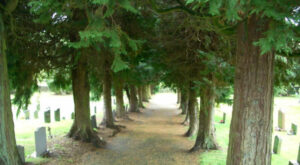
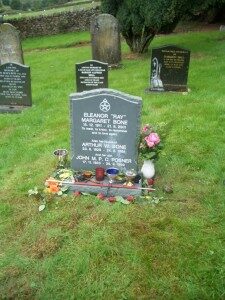 For some people creating an authentic and rooted Paganism means to try to reconstruct faithfully the practices of those who lived a thousand or more years ago. For me this would not provide authenticity; for the essence of Paganism is that it comes from what we find around us in the universe. It must grow and evolve, even as we grow and evolve. This is as true of practice between generations as it is within our own life spans, as our needs evolve and change with age. Rather we seek to know how our immediate predecessors thought and felt and practiced so that we can find inspiration to establish a Paganism that is rooted in the ‘now’, even as they did.
For some people creating an authentic and rooted Paganism means to try to reconstruct faithfully the practices of those who lived a thousand or more years ago. For me this would not provide authenticity; for the essence of Paganism is that it comes from what we find around us in the universe. It must grow and evolve, even as we grow and evolve. This is as true of practice between generations as it is within our own life spans, as our needs evolve and change with age. Rather we seek to know how our immediate predecessors thought and felt and practiced so that we can find inspiration to establish a Paganism that is rooted in the ‘now’, even as they did.